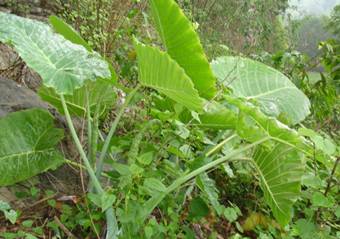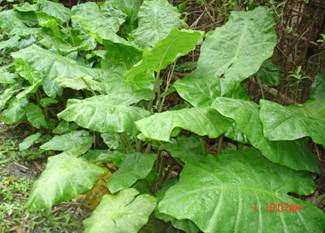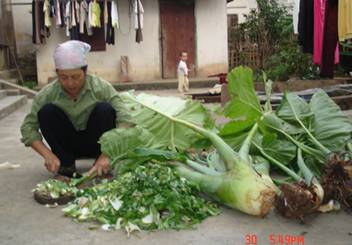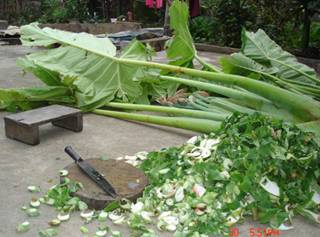Study on the use of
Alocasiamacrorrhiza(roots and leaves) in diets for crossbred
growing pigs under mountainous village conditions in northern Vietnam
Pham Sy Tiep, Nguyen Van Luc, Trinh Quang Tuyen, Nguyen Manh Hung and Tran
Van Tu, NIAH, Hanoi, Vietnam
Abstract
Alocasia macrorrhiza (Giant taro) is a locally available potential feed resource found in the mountainous areas of Northern Vietnam. Two experiments were carried out in Cho Chu village, Dinh hoa District, Thai Nguyen Province with the aim of determining the best ratio of Alocasia macrorrhiza roots and ensiled leaves in the diet for growing pigs and to determine the economical efficiency of using Alocasia macrorrhiza for pigs in household farms in the mountainous areas. Three levels of rice bran (5, 7 and10 %) with 2% molasses (DM basis) in a mixture were evaluated as additives for ensiling Alocasia macrorrhiza leaves. In a second experiment, eighteen crossbred pigs (Yorkshire x Mong Cai) with an initial body weight of 15.0 ± 1.0 kg were divided into 3 groups. In a basal (control) diet (BSD), protein was supplied by soybean meal and fishmeal, and in the other diets ensiled Alocasia macrorrhiza leaves were included as the sole protein sources at levels of 10% (EAL10) and 15% (EAL15) of the DM of the ration.
The results show that ensiling Alocasia macrorrhiza leaves with 7% rice bran and 2% molasses reduced the calcium oxalate content by 78.8%, maintained the pH at 4.05-4.12 until the 60th day, and improved palatability, without reducing the nutritive value of the silage. Including 10% ensiled Alocasia macrorrhiza leaves (replacing fish and soybean meal) with 45% Alocasia macrorrhiza root meal in the diet for crossbred pigs had no negative effects on the performance of the pigs and gave higher benefits for the farmers.
Key words: Alocasia macrorrhiza, Giant Taro, leaves, pigs, protein, roots,
Introduction
It is important to make more efficient use of local feed resources and to improve the economical benefits for smallholder pig producers in the northern mountainous area of Vietnam. Alocasia macrorrhiza is a kind of wild tree growing on the slopes of hills and mountains and today it is also planted in the gardens around smallholdings. The annual yield of fresh Alocasia macrorrhiza root is on average 16 tonnes per ha. There are 3 species of Alocasia macrorrhiza found in the northern mountainous area of Vietnam:
-
Wild Alocasia macrorrhiza, that usually grows in stony, mountainous areas, with very large and thick leaves. Its stems and leaves are dark green in color. This kind is always very itchy and is used only for traditional medicine.
-
"Wavy" Alocasia macrorrhiza (or the Elephant Alocasia macrorrhiza) usually grows by streams or in the wetlands. It has large and wavy leaves and its stems and leaves are green in color. This variety also causes itching, although its stems and leaves are sometimes used for feeding pigs.
-
White Alocasia macrorrhiza (or the "khoai ray") usually grows in terraced fields or is planted in the gardens around the houses. Its stems and leaves are light green in color. This variety is less itchy and its roots, stems and leaves are used for feeding pigs.
Alocasia macrorrhiza roots are rich in starch. Gerpacio and Castillo (1998) reported the following composition of Alocasia macrorrhiza root meal: dry matter (DM) 86.0 %, crude protein (CP) 6.5 %, crude fiber (CF) 4.5 %, Ca 0.38 % and P 0.30 % (in DM).
The leaves of Alocasia macrorrhiza are rich in protein, sugars and vitamins and contain only a little calcium oxalate (Bui Van Chinh 2001). Awunnobi (2002) reported that the chemical composition of the leaves of Taro Cocoyam (Colocasia esculenta) which is similar to Alocasia was (in DM): CP: 12.6%, CF: 6.3%, Ca: 1.05% and P: 0. 31%. The nutritive value of Alocasia macrorrhiza leaves is similar to that of sweet potato vines (Gerpacio and Castillo 1998 ). However, although Alocasia macrorrhiza is a useful, cheap and locally available resource it is still seldom used because of its itching characteristic, as a result of calcium oxalate in the leaves and roots. Pham Sy Tiep et al (2004) carried out a study on the processing and use of Alocasia macrorrhiza roots for pig feed. The results showed that the calcium oxalate could be reduced by chopping, to disrupt the cellular structure of the root, and then soaking the roots in NaOH. After processing the root meal could be included at levels of up to 50% in diets for growing pigs.
The purpose of this study was to:
-
Determine the best ratio of Alocasia macrorrhiza roots and ensiled leaves in the diet for growing pigs.
-
Determine the economical efficiency of using Alocasia macrorrhiza in diets for pigs in smallholdings in the mountainous areas of northern Vietnam.
Experiment 1:Ensiling of Alocasia macrorrhiza leaves with rice bran and molasses
Materials and methods
The experiment was conducted in households in Cho Chu Village, Dinh Hoa district, Thai Nguyen province. The Alocasia macrorrhiza leaves (of White Alocasia or Khoai Ray), including the stems, were chopped into small species 2 - 3 cm in length, sun-dried for 1 -2 hours, and then mixed with 5, 7 or10 % rice bran and 2% molasses (on DM basis) (Photos 1 and 2). The ingredients were mixed thoroughly and kept in plastic bags, tied tightly to keep anaerobic conditions and stored at room temperature (25 - 35oC).
|
|
|
||
|
Photo 1: Alocasia macrorrhiza growing in mountainous areas of Northern Vietnam |
|||
|
|
|
||
| Photo 2: Leaves and stems of Alocasia macrorrhiza | |||
Measurements taken included calcium oxalate, DM and pH level at 0, 7, 14 and 28 days, and the chemical composition of the ensiled leaves determined before processing and at 21 days after processing (CP, ME, CF, EE, NFE, Ca and P). The chemical composition of ingredients was analyzed at the National Institute of Feed Industry, Hanoi, according to AOAC (1990) procedures.
Results and discussion
The pH decreased rapidly in all treatments during the first week and then remained stable until 60 days (Table 1; Figure 1). Increasing the level of additive decreased slightly the pH. As expected, increasing the level of rice bran (Table 2; Figure 2) increased the DM content.
|
Table 1. Effect of additive level on the pH of ensiled Alocasia macrorrhiza leaves |
|||||
|
|
Days |
||||
|
0 |
7 |
14 |
21 |
60 |
|
|
RB5: M2 |
6.02 a |
4.20 a |
4.15 b |
4.12 b |
4.10 b |
|
RB7: M2 |
6.09 a |
4.12 b |
4.10 b |
4.07 b |
4.05 b |
|
RB10: M2 |
6.05 a |
4.10 b |
4.06 b |
3.97 b |
3.42 b |
|
a, b, c: values within rows with differing superscript letters are different (P<0.05) |
|||||
|
Table 2. Effect of additive level on dry matter content (%) in ensiled Alocasia macrorrhiza leaves |
|||||
|
Treatment |
Days |
||||
|
0 |
7 |
14 |
21 |
60 |
|
|
RB5: M2 |
31.9 a |
31.7 a |
31.9 a |
31.7 a |
31.1 a |
|
RB7: M2 |
34.4 ab |
34.2 ab |
34.2 ab |
34.2 ab |
34.13 ab |
|
RB10: M2 |
36.5 b |
36.0 b |
36.8 b |
36.3 b |
35.8 b |
|
a,b: values within row/column with differing superscript letters are different (P<0.01) |
|||||
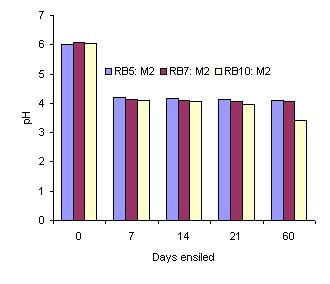 |
 |
|
|
Figure 1. Effect of additive level on the pH of ensiled Alocasia macrorrhiza leaves |
Figure 2. Effect of additive level on the DM content of ensiled Alocasia macrorrhiza leaves |
The calcium oxalate content was reduced markedly by ensiling (Table 3). The high concentrations of crude protein and of phosphorus and low content of calcium are valuable features in the ensiled leaves.
|
Table 3. Effect of additive level on the chemical composition (%) of ensiled Alocasia macrorrhiza leaves at 21 days |
|||||
|
Treatment |
Chemical composition (% in DM) |
mg/kg DM |
|||
|
CP |
CF |
Ca |
P |
Calcium oxalate |
|
|
At 0 day |
|
|
|
|
|
|
RB5: M2 |
28.3 a |
7.4 |
0.13 |
0.45 |
69.5 a |
|
RB7: M2 |
28.7 a |
7.5 |
0.12 |
0.45 |
67.3 a |
|
RB10: M2 |
29.5 a |
7.5 |
0.14 |
0.58 |
66.9 a |
|
At 21 days |
|
|
|
|
|
|
RB5: M2 |
27.1 a |
7.6 |
0.11 |
0.49 |
18.1 b |
|
RB7: M2 |
28.2 a |
7.2 |
0.15 |
0.50 |
14.3 c |
|
RB10: M2 |
28.8 a |
7.1 |
0.15 |
0.54 |
14.1 c |
|
a, b, c: values within columns with differing superscript letters are different (P<0.05). |
|||||
Treatment RB7: M2 was selected for the experimental diets in Experiment 2 as the oxalate content was lower than in RB5:M2 and the color, taste and smell were better than in RB10:M2.
Experiment 2: The effects of Alocaciamacrorrhizaroot meal (AM) and ensiled leaves (EAL) on the performance of fattening pigs
Materials and methods
The experiment was carried out in households in Cho Chu Village, Dinh Hoa District, Thai Nguyen Province. Eighteen crossbred pigs (Yorkshire x Mong Cai) with an initial body weight of 15.0 ± 1.0 kg were allocated to 3 farms, with 6 pigs in each. At each farm, the 6 pigs were divided into 3 groups in a completely randomized design. Two pigs (one male and one female) were kept in one pen and given the experimental diets 3 times per day. Drinking water was freely available from automatic drinkers. The three diets were based on Alocasia macrorrhiza root meal (AMR) and maize and formulated to contain150 g crude protein (CP) kg-1 DM. In the basal (control) diet (BD) protein was supplied by soybean meal and fish meal, and in the other diets ensiled Alocasia macrorrhiza leaves were included replacing some of the soybean and fish meal and maize (Tables 4 and 5). Soybean oil was added at levels of 1.0 and 1.5% to AM10 and AM15, respectively, to equalize the calculated content of metabolisable energy of the diets. A vitamin and micro-mineral mixture was added at 5g kg -1.
Table 4. Chemical composition of the main diet ingredients |
|||||
|
|
AM* |
Maize |
Rice bran |
Soybean meal |
Fish meal |
|
Dry matter (%) |
86.5 |
87.0 |
86.5 |
87.0 |
86.0 |
|
Crude protein (% in DM) |
8.6 |
10.2 |
12.0 |
44.4 |
53.4 |
|
Crude fiber (% in DM) |
3.6 |
1.2 |
8.8 |
7.30 |
1.70 |
|
Ca (% in DM) |
0.11 |
0.08 |
0.17 |
0.29 |
6.55 |
|
P (% in DM) |
0.19 |
0.05 |
1.65 |
0.65 |
3.97 |
|
ME (kcal/kg) |
3150 |
3282 |
2553 |
3316 |
2966 |
|
*: the meal was processed by soaking chopped Alocasia macrorrhiza roots in 3% NaOH solution in order to reduce calcium oxalate. |
|||||
|
Table 5. Ingredient and chemical composition of the experimental diets |
|||
|
|
Control (BD) |
AML10 |
AML15 |
|
Alocasia root meal* |
45.0 |
45.0 |
45.0 |
|
Ensiled alocasia leaves# |
0.0 |
10.0 |
15.0 |
|
Maize |
30.0 |
26.0 |
20.5 |
|
Rice bran |
6.0 |
8.0 |
9.0 |
|
Fish meal |
5.0 |
4.0 |
4.0 |
|
Soy bean meal |
12.0 |
4.0 |
3.0 |
|
Vegetable oil |
- |
1.0 |
1.5 |
|
Vit-min premix |
0.5 |
0.5 |
0.5 |
|
Salt |
0.2 |
0.2 |
0.2 |
|
Lysine |
0.3 |
0.3 |
0.3 |
|
Lime stone |
1.0 |
1.0 |
1.0 |
|
Total (%) |
100 |
100 |
100 |
|
Nutritive value |
|
|
|
|
ME (kcal) |
3008 |
3005 |
3002 |
|
CP (%) |
15.1 |
15.1 |
15.2 |
|
Lysine (%) |
0.78 |
0.70 |
0.70 |
|
Ca (%) |
0.93 |
0.85 |
0.74 |
|
P (%) |
0.54 |
0.48 |
0.40 |
|
Price/kg feed (VND) |
2556.0 |
2261.0 |
2138.0 |
|
* Alocasia root
meal: the meal was processed by soaking chopped Alocasia macrorrhiza
roots in 3% NAOH solution in order to reduce calcium oxalate. |
|||
During the experimental period all the diets were given 3 times per day. Feed offered was around 4% of live weight (DM basis). AML was fed fresh and the other ingredients were cooked. . Feed consumption was recorded by the farmers every day and data collected by the researcher every week. The pigs were weighed at the start of the experiment and monthly during the 2 months of the trial. Parameters determined included daily feed intake, average daily gain, feed conversion ratio and economical efficiency. The data were analyzed using the GLM procedure in MINITAB program 11.2. Sources of variation were treatments and error.
Results and discussion
Feed intake
The feed intake was highest for the AML10 lowest for AML15, which suggests that the highest level of inclusion (15%) of ensiled Alocasia macrorrhiza leaves had a negative effect on palatability (Table 6).
|
Table 6. Effect of different levels of ensiled Alocasia macrorrhiza leaves and root meal on the performance of growing pigs |
|||||
|
|
Control (BD) |
AML10 |
AML15 |
SEM |
P |
|
Feed intake, kg/day |
1.46 a |
1.48a |
1.35b |
0.08 |
0.02 |
|
Initial weight, kg |
15.3 |
15.4 |
15.3 |
0.89 |
0.76 |
|
Final weight, kg |
52.6 a |
52.2a |
49.6b |
1.34 |
0.04 |
|
Duration (days) |
75 |
75 |
75 |
|
|
|
Daily live weight gain, g |
497 |
491 |
457 |
18.5 |
0.11 |
|
FCR, kg/kg gain |
2.6 |
2.5 |
2.9 |
0.08 |
0.04 |
|
Cost of feed, VND/kg |
2556 |
2261 |
2138 |
|
|
|
Feed cost/kg gain, VND |
6 646 a |
6 331 b |
6 200 b |
34.5 |
0.03 |
|
a, b: values
within column with differing superscript letters are significantly
different (P<0.05) |
|||||
Live weight gain,
feed conversion and costs
The daily live weight gain tended to be lower, and the feed conversion poorer, on the AML15 diet compared with AML10 and the control (Table 6). These results are in agreement with Bui Huy Nhu Phuc (2000) and Le Van An (2004), who concluded that cassava leaves and sweet potato leaves can be ensiled successfully, but only used to limited extent as a protein source for pigs. In contrast, Rodriguez et al (2006) found no problems of feed intake and no reduction in growth rate of growing pigs (524 vs 529 g/day) fed fresh leaves of Xanthosoma sagittifolium replacing 50% of the soybean protein in a basal diet of sugar cane juice. Xanthosoma sagittifolium is morphologically similar to Alocasia macrorrhiza but the leaves do not appear to cause "itching" as in the case for Alocasia macrorrhiza. It is not known if this is a factor influencing the nutritive value of the leaves of these two similar species
Feed costs were lowest for the AML15 diet,
indicating that if the farmers ensile Alocasiamacrorrhiza leaves, they can save on
feed costs and get higher economic benefits.
Conclusions
-
Ensiling Alocasia macrorrhiza leaves with 7% rice bran and 2% molasses can reduce the oxalate content by 79% (at 30 days), and maintain the pH at 4.05-4.12 until the 60th day after ensiling, without reducing the nutritive value of the silage.
-
Including 10% ensiled Alocasia macrorrhiza leaves (replacing fish and soybean meal) with 45% Alocasia macrorrhiza root meal in the diet for (Yorkshire x Mong Cai) crossbred pigs had no negative effects on performance and resulted in higher benefits for the farmers in mountainous villages in Northern Vietnam.
References
AgwunobiL N, Angwukam P O, Cora O O and Isik M A
2003: Studies on the use of Colocasia esculenta
(taro coco yam) in the diets of weaned pigs. Tropical Animal Health
and Production, 34:3, 241-247.
An LV, Hong T T T and Lindberg J E 2004: Ileal and total tract digestibility in growing pigs fed cassava root meal diets with inclusion of fresh, dry and ensiled potato leaves. Animal Feed Science and Technology, 114, 127-139.
AOAC 1984: Official Methods of Analysis. Association of Official Analytical Chemists. 15th edition. Arlington, USA
Bui Huy Nhu Phuc, Ogle B and Lindberg J K 2001 Nutritive value of cassava leaves for monogastric animals. International Workshop "Current Research and Development on use of Cassava as Animal Feed". p 31-40. http://www.mekarn.org/procKK/phuc.htm
Gerpacio A L and Castillo L S 1998:Nutrient
composition of some Philippines feedstuffs. Los Banos, 12-24 pp.
Pham Sy Tiep, Nguyen Van Luc and Dang Hoang Bien 2005: Processing and use of Alocasia macrorrhiza (taro) roots for fattening pigs under mountainous village conditions; Workshop-seminar "Making better use of local feed resources" (Editors: Reg Preston and Brian Ogle) MEKARN-CTU, Cantho, 23-25 May, 2005. Article #44. RetrievedOctober 23, 106, from http://www.mekarn.org/proctu/tiep44.htm
Rodríguez Lylian, Lopez D J, Preston T R and Peters K 2006 New Cocoyam (Xanthosoma sagittifolium) leaves as partial replacement for soya bean meal in sugar cane juice diets for growing pigs. Livestock Research for Rural Development. Volume 18, Article #91. Retrieved September 11, 2006, from http://www.cipav.org.co/lrrd/lrrd18/7/rodr18091.htm
